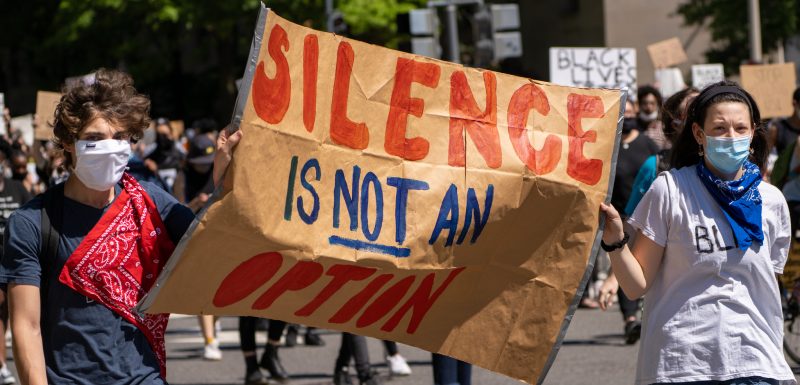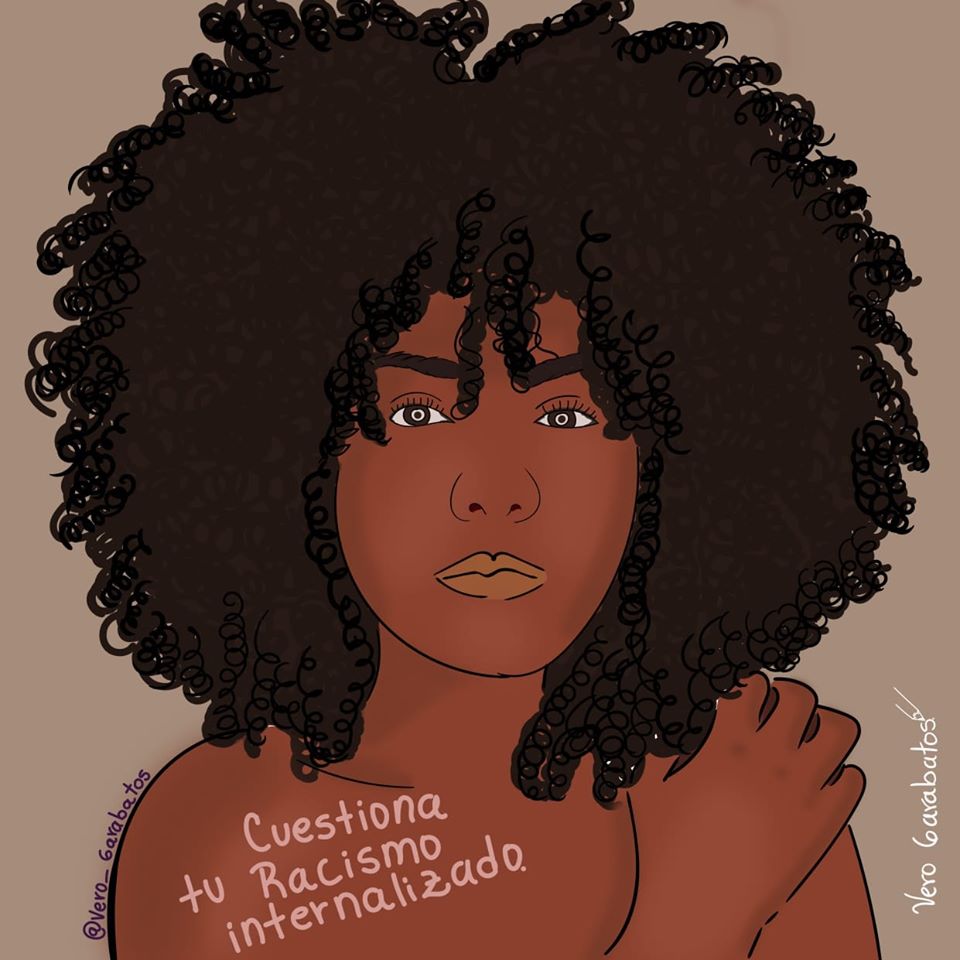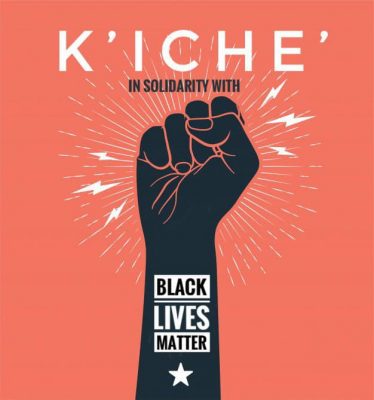"Your life is shaped by the privileges of your whiteness."
Posted 6 June 2020

Two white protestors display a sign reading “Silence is not an option”, as part of the George Floyd protests that took place in Washington D.C. on May 30, 2020. Photo by Victoria Pickering on Flickr, CC BY-NC-ND 2.0.
In the aftermath of the killing of George Floyd, a black American, by a white police officer in Minneapolis on May 25, 2020, there have been #BlackLivesMatter protests not only in the United States but around the world.
In the Caribbean, Floyd's death has prompted widespread online discussion about the region's own complicated race relations. In Trinidad and Tobago, this has been fuelled by disrespectful remarks from business owners and others widely regarded to occupy positions of privilege in society.
A key point of contention is the trotting out of the phrase “All Lives Matter” in response to expressions of support for the “Black Lives Matter” movement, with many older white or “white-adjacent” Trinbagonians failing to recognise how the phrase — which many of them interpret to be unifying or all-encompassing — is in fact just another form of belittlement.
Now, two young Trinbagonians, Anya Quesnel and New York-based Charlie Reid, have posted their thoughts about the issue, holding up a mirror to their community to show them the ways in which they participate in racism, in the hope that self-examination will inspire them to use their privilege to create equity.
What is ‘white privilege'?
Recalling an incident in which his mother was given a delivery of pizza on trust because she had no cash with which to pay at the time of delivery, Reid defines white privilege this way:
Though your life may be chock-full with struggle, though you may have worked honest and hard for every cent you’ve ever earned, the colour of your skin has not been something that has significantly made your life harder. Your whiteness has not been something you must compensate for. Your whiteness has not caused you grave trauma. And if for some unique reason — in a Trinidadian context — your whiteness has caused you discomfort, never will it be comparable to the trauma our non-white brothers and sisters experience and have experienced.
In the Trinidad and Tobago context, however, Reid has noticed that privilege is closely intertwined with nepotism, which he says “has mated with race to evolve into this hybrid of white privilege that blows the white privilege I experience and have witnessed in America totally out of the water”.
The problem with ‘not seeing colour’
In a multiethnic society like Trinidad and Tobago, diversity is visible. Quesnel put it into historical context:
One should never be looking at any part of Trininess without nuance and respect for the complexity of what it means to be a post-colonial (not decolonized) nation. […] By claiming that ‘we doh see colour, we doh see race’, we are ignoring that certain bodies are marked differently to others, and to harmful ends. When you tell your Black friends that you do not ‘see them as black’ you are 1) already displaying your assumption that blackness is inherently a ‘bad thing’, 2) you are invalidating the lived experiences of that friend that have been shaped by their blackness (as yours have been shaped by your whiteness). You are not being racist when you acknowledge that race exists. You are being racist when you fail to acknowledge your own prejudices.
Reid added:
Colour blindness is erasure. By not ‘seeing’ the colour of a person’s skin, you are not acknowledging their hurdles and your privileges. And so, stop being blind. If you are white, see your whiteness, see your neighbor’s blackness, see all the colours in between, celebrate it, witness it, and most importantly, take responsibility for the way the world treats you as a result of it. If you cannot see how the world treats you differently — that’s where your homework begins.
Deal with the discomfort
Part of the process is having difficult conversations and confronting stark, often unpleasant realities. Quesnel's advice?
Sit with that discomfort. Ask why. Know that that your life is always, always, shaped by the privileges you have been afforded because of your whiteness.
Asserting that “reverse racism does not exist”, Reid added:
Perhaps, as a white Trini, you did in fact experience discomfort or harassment because of your whiteness. In Trinidad, as a racial minority, I have experienced hostility due to the colour of my skin [but] the cost of the discomfort that I experienced was inconceivably small to the cost people of colour experience due to racism and racist systems. So, we must discuss and continuously call out the systems at play.
The issue of culture
In a multicultural space where claiming ownership of culture can get tricky, Quesnel challenged people to walk the talk:
Listen now. Let us be very aware of where the Trini ‘culture’ we parade so proudly came from: struggle. Specifically the struggle of black and brown Trinis to claim a space in the colonized society. […] If we so proud to be Trini to the bone why we bad talk public schools, send our children to private schools in the west when some of us sitting on money we could funnel into reforming public school education and bettering public facilities? Show that T&T pride by investing at home, by investing in home. Loving where you come from is more than patriotic talk for social capital.
The language of race
Both young people were cognisant of the fact that the ways in which race is spoken about matters. Whether it's the use of pejorative terminology, denial that racism and colour-based social separation exists, or discussing sensitive issues like crime in terms of race, words have power.
Given that one of the most beloved lines in the country's national anthem is “Here every creed and race find an equal place”, Quesnel advised people to educate themselves and engage in dialogue:
Know YOUR history. Sit with the discomfort, rage, confusion that kind of work and introspection does. We need to examine and reimagine the ‘place’ every creed and race [is] trying to find equality in. […] If we cannot talk about the legacies of trauma, plundering, violence, genocide and prejudice that are ever present in our day to day- there will be no equality. If the art, voices, feelings, experiences and dreams of Black people are devalued constantly, there will be no equality.
Reid, who admitted he was struggling with “how to say this all perfectly” and conscious of not wanting to make himself “the center of this discourse”, admitted that he did once think of racism “as this bad thing that black people face”:
As I became more educated, I thought of racism as this bad thing that affects all people of colour, and not whites, and as a white person, it was my job not to be ignorant and make it harder for them. Today, I see racism as an issue that white people have. […] This is […] not to put white people at the center of this narrative, but rather to put white people at the center of accountability. […]
The time has long come for us as white people, especially as white Trinis, to talk about racism, as uncomfortable as it may be. It is not enough to say to yourself, ‘But I’m not racist.’ As — a golden tidbit — you are. We all are. I am. We are racist by the very fact that we operate and exist and benefit from the systems that have long favored our whiteness. Uprooting this will take lifetimes of concerted efforts. And people of colour have had enough. It’s time for us in our whiteness to say something, do something, fix something — fix it.
Written byJanine Mendes-Franco



















